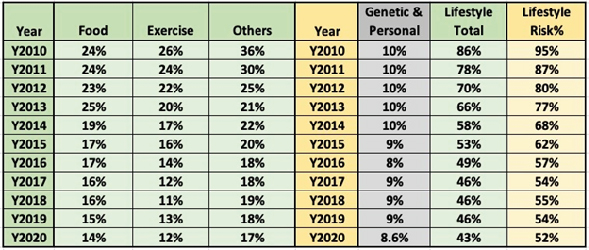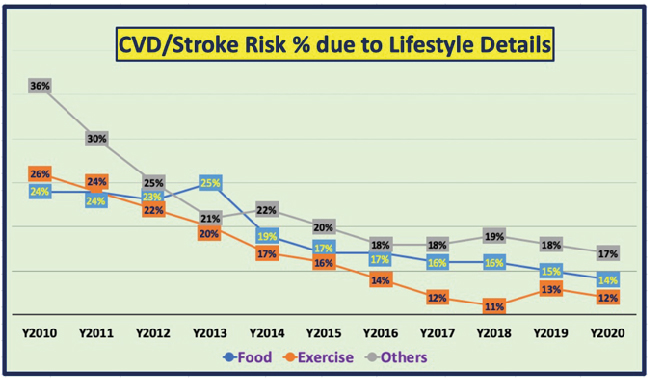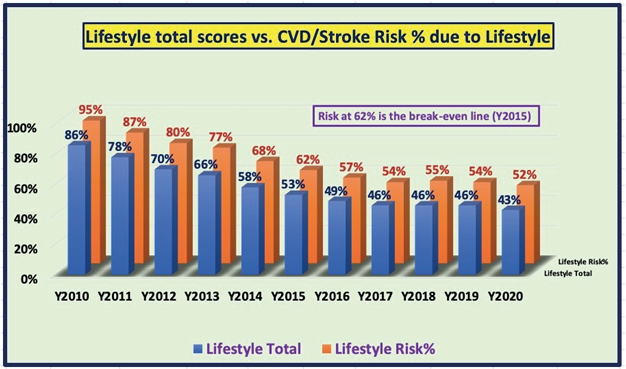The author uses his developed GH-Method: math-physical medicine approach to investigate a more detailed contribution analysis of three lifestyle management sub-categories with nine elements on his risk probability percentages of having cardiovascular disease (CVD) or stroke.
Listed below is his annualized risk probability percentage based on Lifestyle of having CVD or stroke:
Y2010: 95%
Y2011: 87%
Y2012: 80%
Y2013: 77%
Y2014: 68%
Y2015: 62%
Y2016: 57%
Y2017: 54%
Y2018: 55%
Y2019: 54%
Y2020 : 52%
This article describes the individual contributions from three lifestyle management sub-categories (food, exercise, and others) with nine detailed elements on the risk probability percentage of having CVD or stroke. His research results from the past 10+ years have demonstrated the importance of maintaining an excellent healthy state for the entire body via a stringent lifestyle program in order to reduce the risk of having CVD or stroke.
Emphasis has been placed on the significance and contributions from three sub-categories with nine elements in a quantified manner. As a result, the findings are corroborated with the advice from healthcare professionals to their patients.
The author uses his developed GH-Method: math-physical medicine (MPM) approach to investigate a more detailed contribution analysis of three lifestyle management sub-categories with nine elements on his risk probability (Risk) percentages of having cardiovascular disease (CVD) or stroke.
To learn more about the MPM method, readers can review the article in Reference 1, along with the outlined history of his personalized diabetes research and application tools development in Reference 2 [1, 2].
In 2014, the author applied topology concept, finite-element engineering technique, and nonlinear algebra operations to develop a ten dimensional complex mathematical model of metabolism which contains four output categories (weight, glucose, blood pressure, lipids and other lab-tested data (ACR, TSH, and others), and six input categories (food, water intake, exercise, sleep, stress, and routine life patterns), and ~500 detailed elements. He further defined two new parameters, metabolism index (MI), as the combined score of the above 10 metabolism categories (dimensions) and 500 detailed elements, and general health status unit (GHSU), as the 90-days moving average value of MI. Please note that Mi (where i = 1 through 10) represents individual metabolism score of each category. Since 2012, he has collected ~2 million data of his own biomedical conditions and personal lifestyle details. He only utilized a part of his big database for analysis work in this article [3].
Next, he developed a few suitable algorithms containing some different weighting factors which include a patient’s baseline data such as gender, age, race, family genetic history, medical history, bad habits, BMI, and waistline. After continuously collecting sufficient input data, he can then conduct the following three sets of calculations:
A. Medical conditions - individual M2 through M4 for diabetes, hypertension, hyperlipidemia, and others. These three metabolic disorder values include patient’s self-collected biomedical data and the lab-tested medical examination results.
B. Lifestyle details - individual M5 through M10 which affect medical conditions directly or indirectly. In this category, he includes the following 3 sub-categories with a total of 9 detailed elements.
(B-1). 3 foods: quantity, quality, and carbs/sugar amount.
(B-2). 2 exercises: daily walking steps and post-meal waking steps.
(B-3). 4 others: water intake, sleep, stress, and daily life routines.
C. MI & GHSU scores - MI is a combined score of M1 through M10 using engineering finite element method technique. GHSU is the 90-days moving average MI curve which can show the MI’s trend clearly.
With this developed mathematical risk assessment tool, he can obtain three separate risk probability percentages associated with each of these three calculation models mentioned above. As a result, this tool would offer a range of the risk probability predictions of having CVD or stroke, depending on the patients’ medical conditions, lifestyle details, or the combined metabolism impact on the human body [4].
The author is a 73-year-old male who has a history of three severe chronic diseases for over 25 years. He experienced five cardiac episodes from 1994 through 2008 and was diagnosed with an acute renal problem in early 2010. In addition, he also suffered from foot ulcer, bladder infection, diabetic retinopathy, and hypothyroidism. He weighed 220 lbs. in 2000 and his HbA1C level was 10.0% in 2010.
In 2014, he developed mathematical metabolism model and started his stringent lifestyle management program. As a result, his overall health conditions have been noticeably improving since 2015 when he started to reduce the dosage of his diabetes medications. By the end of 2015, he completely stopped taking them. During the entire period of 2016-2019, his HbA1C average value was 6.6% without medication. During the recent COVID-19 quarantine period from 1/19/2020 to 8/22/2020, his HbA1C has further decreased to 6.1%.
The author has written a few medical papers regarding the subject of risk probability of having CVD or stroke based on the annual data when available (Reference 3). The difference between this article and his previous ones is two-fold. First, in this article, he focuses on individual contributions from three sub-categories of lifestyle rather than taking the overall performance score of lifestyle details to conduct his risk calculations. Secondly, he changed a few “weighting factors” in his algorithm in order to reflect some of his newly acquired knowledge on different diseases. However, this weight factor change only reflects some nominal or insignificant changes on his risk probability percentages of having CVD or stroke. The overall trend and significant levels remain the same as his previous papers [5].
In Figure 1, it illustrates the background data table of his analysis results.
Three contribution percentage line charts of food, exercise, and others are shown in Figure 2.

Figure 1. Background Data Table of CVD/Stroke Risk Probability % Based On Lifestyle Details

Figure 2. Contribution % of Food, Exercise, and Others to CVD/Stroke Risk Probability Based on Lifestyle
The comparison of two sets of bar charts, where one bar set is the summation of contribution percentage of food, exercise, and the other bar set is the CVD/stroke risk % based on lifestyle input (Figure 3).

Figure 3. Comparison between Total Lifestyle % vs. CVD/Stroke Risk % Based on Lifestyle
The established “pre-established targets” of his lifestyle performance are as follows:
Food Quantity: 50%
Food Quality: 50%
Carbas/Sugar: 20 grams
Daily Walk: 10,000 steps
Post-Meal Walk: 4,000 steps
Water-Intake: 2,000 cc
Sleep Quality: 50%
Stress: 50%
Daily Life Routine: 50%
If the patients meet all of the above targets, they will achieve a “break-even” score of ~52%. Since no person would have a “perfect” score on his or her genetic and personal long-term factors, the author could provide an average score of ~10% for a worst-case scenario of 20%. As a result, the combined “break-even” risk probability percentage of having CVD or stroke is ~62%. If the risk percentage is higher than 62%, this indicates a higher risk. However, if the risk percentage is lower than 62%, this implies a lower risk [5].
The three percentages of food, exercise and others are declining year after year due to his stringent lifestyle management program (Figure 2). From judging his three curves over the period of 2017-2020 and the knowledge of his developed mathematical metabolism model, he is able to reach a “near-optimal” state (i.e. high cost/return ratio) in terms of further potential improvements on managing his food, exercise, and others. Another observation is that it usually takes many years of efforts to be able to turn around our health state, including both medical condition reversal and lifestyle improvements.
The following information from 2020 demonstrates the above observations and highlights of his lifestyle improvements over the recent COVID-19 quarantine period (1/19-8/22/2020):
Food Portion: 67.7% of normal
Food Quality: 50.1% (50% is best)
Carbs/Sugar: 12.2 grams per meal
Daily Walk: 15,904 steps per day
Post-Meal Walk: 4,280 steps per meal
Drinking Water: 2,984 cc per day
Sleep Quality: 59.7% (50% is best)
Stress: 50.0% (50% is the best)
Daily Life Routine: 70.0%
Since 2012, the author kept detailed and completed data from the past 8.5 years. In 2010 and 2011, he could only use some spotted records for guesstimated results, but the data still represent his previous years’ situation accurately [3].
The final calculated total lifestyle scores and CVD/stroke risk percentage are descending year after year (Figure 3). Even though 2010 and 2011, involved guesstimated data, they were alarmingly high with ~80% for total lifestyle score and ~90% for CVD risk. This explains why he suffered many diabetic complications prior and during this time. The “turning-point” was 2015, when his lifestyle score and CVD risk decreased to ~52% and ~62%, respectively. Finally, during 2020, his lifestyle changed dramatically due to the quarantine impact on his diet, exercise, sleep, stress, daily routines, and so forth. In other words, he worked even harder to maintain his stringent lifestyle management program. Finally, his lifestyle score and CVD risk reduced to ~43% and ~52%, respectively.
Listed below is a table of his annualized risks probability based on Lifestyle of having CVD or stroke (Figure 3):
Y2010: 95% (weight 198 lbs., BMI 29.2, waistline 44 inches, glucose 280 mg/dL)
Y2011: 87% (glucose 200 mg/dL)
Y2012: 80% (glucose 128 mg/dL)
Y2013: 77% (glucose 133 mg/dL)
Y2014: 68% (developed metabolism model, glucose 135 mg/dL)
Y2015: 62% - crossing the break-even line of 62% (weight & FPG control, glucose 129 mg/dL)
Y2016: 57% (PPG control & stopped medication, glucose 119 mg/dL)
Y2017: 54% (BMI 25, glucose 117 mg/dL)
Y2018: 55% (heavy traveling, glucose 116 mg/dL)
Y2019: 54% (heavy traveling, glucose 114 mg/dL)
Y2020 : 52% (weight 172 lbs. BMI 25, waistline 33 in, glucose 109 mg/dL)
Through his previous research for the past 5 years, he already detected that glucose is the “principal criminal” and blood pressure with lipids are the “accessory criminals” in terms of induced complications from chronic diseases, specifically CVD, stroke, renal problems, diabetic retinopathy, and even cancers. This is why he included the situations of his weight and glucose data in the above table.
Due to his heavy travel schedules of attending more than 60 medical conferences from 2018-2019, his risks jumped up from 54% in 2017 to 55% in 2018; however, during the stabilized quarantined life in 2020, it has actually assisted in lowering his risk probability percentage to 52% [4].
It should be noted that the risk probability percentages are expressed on a “relative” scale and not on an “absolute” scale. However, by keeping the “break-even” line of 62% in mind, one can quickly judge the different severe levels from the calculated CVD/stroke risk probability percentages.
This article describes the individual contributions from three lifestyle management sub-categories (food, exercise, and others) with nine detailed elements on the risk probability percentage of having CVD or stroke. His research results from the past 10+ years have demonstrated the importance of maintaining an excellent healthy state for the entire body via a stringent lifestyle program in order to reduce the risk of having CVD or stroke [5].
This article has emphasized the importance and contribution of three specific sub-categories with nine elements in a quantified manner. These findings are corroborated with the advice from healthcare professionals to their patients.
- Hsu Gerald C (2020) EclaireMD Foundation, USA: “Biomedical research methodology based on GH-Method: math-physical medicine (No. 310).
- Hsu Gerald C (2020) EclaireMD Foundation, USA: Glucose trend pattern analysis and progressive behavior modification of a T2D patient using GH-Method: math-physical medicine (No. 305).
- Hsu Gerald C (2020) EclaireMD Foundation, USA. Using mathematical model of metabolism to estimate the risk probability of having a cardiovascular diseases or stroke during 2010-2019 via GH-Method: math-physical medicine (No. 255).
- Hsu Gerald C (2019) EclaireMD Foundation, USA. Using GH-Method: math-physical medicine to investigate the triangular dual-correlations among weight, glucose, blood pressure with a Comparison of 2 Clinic Cases (No. 043).
- Hsu Gerald C (2019) EclaireMD Foundation, USA. Using GH-Method: math-physical medicine and signal processing techniques to predict PPG (No. 013).



